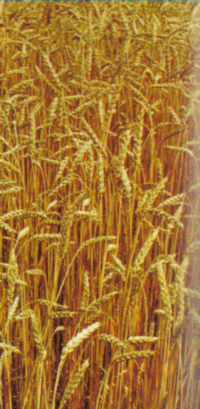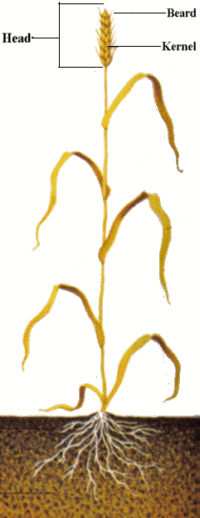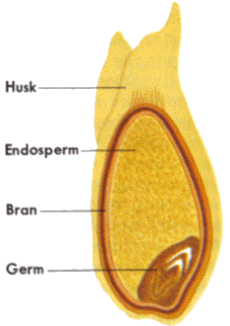 SKC Films Library |
||||
| SKC Films Library >> Agriculture >> Plant Culture >> Field Crops | ||||
| Wheat the world's most important grain crop
Wheat is a grass-type plant that belongs to the group of grains called cereals, which also includes rice, oats, corn, barley, and rye. A common food staple in North and South America, Europe, Africa, Australia, and much of Asia, wheat covers more of the earth's surface than any other food crop. In most Western countries, wheat appears in some form at almost every meal. Wheat flour is used to make bread, rolls, buns, cookies, cakes, and other goods. Many ready-to-eat breakfast cereals are made with wheat, as are cream of wheat and farina. Coarse particles of wheat are mixed into a paste and forced through machines to make various types of pasta. Wheat paste is rolled into sheets and cut into strips for noodles. The bran layer and some other parts of the kernel that remain after milling are used as livestock and poultry feed. Wheat grains not suitable for milling are also fed to animals. Glutamic acid, a by-product of wheat, is used to make monosodium glutamate (MSG), which in turn is used to bring out the flavor of other foods. Wheat may also be used to produce alcohol for synthetic rubber or munitions. Flour paste, the filler for insect-destroying preparations, and certain coffee substitutes require wheat. Strawboard used in boxes and straw for fertilizer and other uses are products made from the stem of the wheat plant. The Wheat Plant The wheat plant is a bright green color, and it turns golden-brown when ripe. It may grow up to 5 feet tall. Most of the root system is in the upper 15 to 20 inches of the soil. The leaves are long and slender. The wheat head that holds the kernels is at the top of the main center stem. Many varieties of wheat have coarse, prickly hairs called beards on the husk of the wheat kernel. A healthy plant produces an average of fifty kernels of wheat. The clusters of kernels cling tightly to the stem until they are fully ripe.
The wheat kernel is 1/8 to 1/4 inch long. It is divided into three main parts -- the germ, the bran, and the endosperm. The germ is the part where growth starts after the seed is planted. It makes up a small part of the kernel. The bran, or "coat," is made up of several layers that protect the kernel. It is much like the shell of a nut. The bran makes up about 15 per cent of the kernel and is used primarily in making livestock feed. The endosperm makes up the largest part of the kernel, about 85 per cent. It is used in making bread and other bakery goods. The endosperm contains a protein called gluten that makes dough rise in the presence of yeast. The husk of the kernel is called chaff.
Kinds of Wheat There are two general groups of wheat, winter and spring. The kind planted depends primarily on the climate. Winter wheats are used in mild climates, are planted in the fall, and harvested the following spring or summer. Winter wheat gets a start before cold weather begins. Growth stops during the winter, then begins again in the spring. Spring wheat is planted in the spring and ripens the same summer, usually a few weeks after the winter wheat. All the wheat grown throughout the world belongs to one of fourteen species:
Seven of these species are grown in the United States, but only three are of special importance. Common and club wheats are the most commonly used wheats for making bread and other baked goods. The most important common wheat states are Texas, Kansas, Nebraska, Oklahoma, Colorado, North and South Dakota, Montana, and Minnesota. Club wheats are grown only in the Pacific Coast states. Durum is a hard, tough wheat. Spaghetti, macaroni and other pastas are made from durum because its flour holds together well while cooking. In North America, durum wheat grows in North and South Dakota, Montana, and Minnesota, and in parts of Canada. History Wheat was originally a wild grass. Evidence exists that it first grew in Mesopotamia and in the Tigris and Euphrates River valleys in the Middle East nearly 10,000 years ago. As early as 6,700 B.C. Swiss lake dwellers used wheat in flat cakes. It was the Egyptians who discovered how to make yeast-leavened breads between 2,000 and 3,000 B.C. Since wheat is the only grain with sufficient gluten content to make a raised or leavened loaf of bread, wheat quickly became favored over other grains grown at the time, such as oats, millet, rice, and barley. The workers who built the pyramids in Egypt were paid in bread. Wheat is not native to the United States. It was not grown by the colonists because it did not do well in the New England soil and climate. In 1777, wheat was first planted in the United States -- as a hobby crop. In the Pacific Northwest, wheat was grown at a trading post in Fort Vancouver, Washington, as early as 1825. By 1860, Indiana and Illinois were the leading wheat-producing states. Wheat acreage expanded in Kansas and Oklahoma after 1873, when Mennonite immigrants from Russia settled there. They brought with them a new variety of wheat called Turkey Red. This variety of wheat was far better than those in use, and soon spread throughout Kansas and the rest of the Great Plains. For the next sixty years, practically all the wheat produced in the Great Plains was Turkey Red, or some closely related variety. Although most of the early wheats are no longer grown for commercial production, Turkey Red and its variants made the region the "Bread Capital of the World."
|
||||
| SKC Films Library >> Agriculture >> Plant Culture >>
Field Crops This page was last updated on 10/30/2017. |


